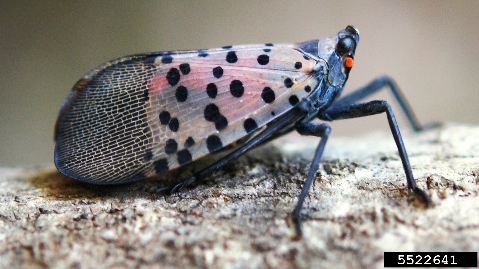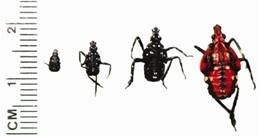Spotted Lantern Fly

Spotted Lantern Fly Information:
The spotted lanternfly, Lycorma delicatula (often abbreviated as SLF), is native to China, and is present in several countries in Asia. In 2014 it was found in Pennsylvania where it has since spread to 26 counties. Established populations are present in several other states, including in Frederick and Clarke Counties, VA. A map that shows areas with confirmed spotted lanternfly observations is available here from Cornell University.
SLF is a planthopper. Adults are 1" long and have very distinct colors and patterns on their wings. Young instars (nymphs) start off black with white spots and turn red right before maturity. Eggs are laid together in rows, often covered with a sticky mud-like substance. Egg masses when new are usually gray and shiny, and are around 1" long. When they are old they become darker and often show cracking, exposing more individual eggs. Eggs can be laid without the mud like covering.
Much like Gypsy Moth egg masses, there is a high risk of accidental movement of SLF eggs. SLF will lay egg masses on trees, but can also lay them on almost any other surface such as bricks, stone, lawn equipment, vehicles, and wood.
The preferred tree species for SLF as an adult and late stage nymph is tree of heaven, Ailanthus altissima. Tree of heaven is a non-native invasive tree that can be found throughout Prince William County. It is often in disturbed habitats, particularly along wood edges. See what Tree of Heaven looks like here. Nymphs and adults can be seen crawling up and down trees and will also congregate together in large groups to feed. SLF feeds on sap. Feeding can lead to oozing sap visible on the surface of trees and dark mold or fungi growing beneath the feeding area which can attract other insects.
While grape vines are highly vulnerable to this pest, many tree species are also affected including: fruit trees, oak, pine, tulip poplar, walnut, maple, poplar, hickory, willow, sycamore, birch, elm, basswood, sassafras, serviceberry, ash, black gum, and black cherry. Federal and State agencies are working to determine the distribution and risk of this invasive insect to US forests.
Monitoring and Reporting this pest:
Spotted lanternflies have been confirmed in our region. Early detection can help to prevent this pest from establishing and spreading in our area.
If you see any potential life stages of Spotted Lanternfly please report it- three options for reporting:
- Send your photos to the Arlington Virginia Cooperative Extension Horticulture Help Desk at mgarlalex@gmail.com
- "Ask Extension" widget.
- Anyone who finds a spotted lanternfly should report it to VDACS, kill it or keep it until it can be confirmed it is a spotted lanternfly. A report can also be made at spottedlanternfly@vdacs.virginia.gov
Resources:
- The spotted lanternfly is a threat to many fruit crops and trees. Learn how to spot it and report it. (USDA)
- Spotted Lantern Fly in Virginia (Virginia Cooperative Extension)
- Spotted Lantern Fly Information (Fairfax County)
- Spotted Lanternfly: What is it & why does it matter? (Pennsylvania Dept of Agriculture)





